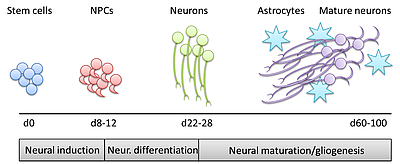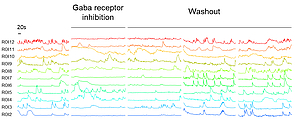Bio-engineered neuronal organoids from human stem cells
In vitro 3D modeling of neural tissues represents a powerful tissue bioengineering tool permitting the study of complex neuronal cell systems. Despite the advances in human neuronal organoid generation, there still exist numerous deficiencies limiting the utility of existing neuronal organoids. Scientists at the University Medical Center of University Göttingen developed a robust, reproducible and fully defined method for serum-free production of human bio-engineered neuronal Organoids (BENOs) from stem cells having functional neuronal network activity.
Challenge
Despite the advances in human organoid generation, there are numerous deficiencies limiting the use of existing neuronal organoids. For example, organoids produced by today's methods commonly display high phenotypic variability. This is partially due to a routine use of Matrigel as a neurogenesis supporting substrate.
Another drawback associated with known methods is a lack of neuronal network function, which significantly limits their use in investigating neuronal functionality and plasticity. As current methods do not resemble normal tissue function they are not well suited for disease modeling, drug development and drug screening.
Thus, there is a need for methods generating neural organoids based on chemically defined components in order to allow consistency in the structures produced. Moreover, there is a need to produce neural organoids capable of forming functional neural networks that mimic natural neural structures.
Our Solution
Scientists at the University of Göttingen, Department of Pharmacology and Toxicology, developed a robust, reproducible and fully defined method for serum-free production of human bio-engineered neuronal organoids (BENOs) from stem cells. This new method will permit both, (i) a robust and reproducible neuronal differentiation in a well-defined 3D cell culture system and (ii) assessment of neuronal network performance.
Advantages
- Protocol for robust and reproducible neuronal differentiation in a defined 3D cell culture system
- BENOs are formed by culturing pluripotent stem cells (iPSC) in a Matrigel-free collagen matrix within 40-60 days.
- BENOs recapitulate normal cortical layer development and contain a variety of neurons and glia cells.
- BENOs have first neuronal activity at day 32.
- Presence of a functional neuronal network:
- Spontaneously synchronized neurons becoming asynchronous upon GABA Receptor inhibition,
- Upon inhibitor washout, the same neurons re-synchronize.
- BENOs at a defined stage of development show the propensity for regenerative rewiring after injury.
 Time-course of neuronal organoid development. Source: EP17175874.1
Time-course of neuronal organoid development. Source: EP17175874.1
Applications
- Drug Screening for biological activity (neuronal network activity),
- Neuroregeneration of lead compounds and identification of mechanism of action.

Spontaneous and induced calcium activity. Representative calcium measurement of gabaergic network activity at day 32:
- Matlab analysis of different regions of interest (ROI) indicated 12 different traces. Before GABAR inhibition ROI (2,3), ROI (4,5), ROI (6,7) and ROI (11,12) were synchronized.
- GABAR inhibition (picrotoxin, saclofen) led to cell de-synchronization.
- Upon washout, the same neurons re-synchronized suggesting the presence of a functional GABAergic network. Source: EP17175874.1
Developmental Status
The new method has been successfully established resulting in human BENOs with fully functional neuronal network activity. Furthermore, a screening platform is currently developed into an automated process.
Patent Status
Granted EP patent (EP3415618B1, validated in AT, BE, CH, DE, DK, ES, FR, GB, IE, IT, LU, NL, SE) and further international patent applications in US, CA, AU, CN, JP, KR, SG, IN (Patent holder/Applicant: Georg-August-Universität Göttingen public law foundation).
This IP is free for license for generation of lab-grown tissues for Toxicity & Drug Screening outside Europe.
References
Zafeiriou et al.: Developmental GABA polarity switch and neuronal plasticity in Bioengineered Neuronal Organoids. Nature Communication, 2020, 11, 3791. https://doi.org/10.1038/s41467-020-17521-w
Contact
Dr. Stefan Uhle
Patent Manager Life Science
E-Mail: Diese E-Mail-Adresse ist vor Spambots geschützt! Zur Anzeige muss JavaScript eingeschaltet sein!
Tel: +49 551 30724 154
Reference: BioC-2047-UMG
Tags: Therapie

